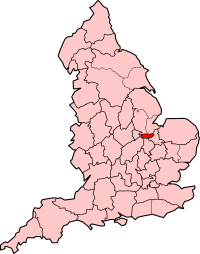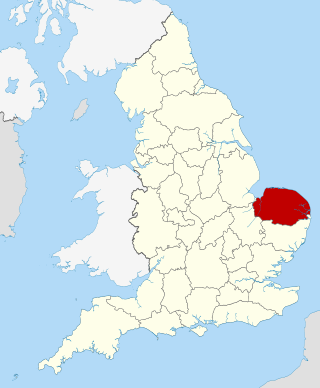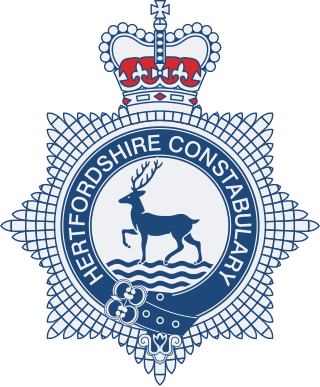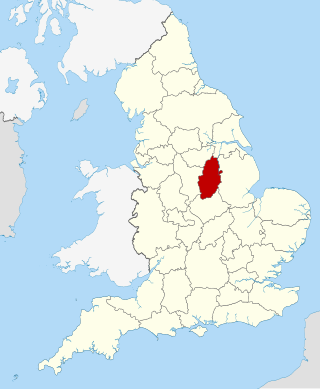
The Soke of Peterborough was a historic area of England associated with the City and Diocese of Peterborough. It was part of Northamptonshire, but was administered by its own county council, while the rest of Northamptonshire was administered by Northamptonshire County Council. The Soke was also described as the Liberty of Peterborough, or as the Nassaburgh hundred, and comprised, besides Peterborough, about thirty parishes. The Soke was abolished in 1965.

Cambridgeshire Constabulary is the local territorial police force that covers the county of Cambridgeshire and Peterborough unitary authority. It provides law enforcement and security for an area of 1,311 square miles (3,400 km2) and population of 856,000 people, in a predominantly rural county. The force of Cambridgeshire includes the cities of Cambridge, Ely and Peterborough, the market towns of Chatteris, Huntingdon, March, Ramsey, St Ives, St Neots, Whittlesey, and town and Port of Wisbech. Its emblem is a crowned Brunswick star containing the heraldic badge of Cambridgeshire County Council.

Norfolk Constabulary is the territorial police force responsible for policing Norfolk in East Anglia, England. The force serves a population of 908,000 in a mostly rural area of 2,079 square miles (5,380 km2), including 90 miles (140 km) of coastline and 16 rivers, including the Broads National Park. Headquartered in Wymondham, Norfolk is responsible for the City of Norwich, along with King's Lynn, Great Yarmouth and Thetford. As of March 2023, the force has a strength of 1,897 police officers, 163 special constables, 1,318 police staff/designated officers, and 103 police support volunteers. The Chief Constable is Paul Sanford, and the Police and Crime Commissioner (PCC) is Sarah Taylor (Labour).

The City of Glasgow Police or Glasgow City Police was the police covering the city and royal burgh of Glasgow, from 1800 to 1893, and the county of city of Glasgow, from 1893 to 1975. In the 17th century, Scottish cities used to hire watchmen to guard the streets at night, augmenting a force of unpaid citizen constables. On 30 June 1800 the authorities of Glasgow successfully petitioned the British Government to pass the Glasgow Police Act 1800 establishing the City of Glasgow Police. It served Glasgow from 1800 to 1975, when it was amalgamated into Strathclyde Police.

Leicestershire Police is the territorial police force responsible for policing the counties of Leicestershire and Rutland in England. Its headquarters are at Enderby, Leicestershire.

Hertfordshire Constabulary is the territorial police force responsible for policing the county of Hertfordshire in England. Its headquarters is in Welwyn Garden City. The current chief constable is Charlie Hall. As of March 2019, the force consists of over 1,900 police officers, 235 PCSOs, and over 1500 police staff, as well as being supported by more than 410 special constables.

Durham Constabulary is the territorial police force responsible for policing the council areas of County Durham and Darlington in North East England. It does not cover all of the ceremonial or historic area of Durham, parts of which are covered by the neighbouring forces of Cleveland Police and Northumbria Police. The other neighbouring forces are Cumbria Constabulary to the west and North Yorkshire Police to the south.

Nottinghamshire Police is the territorial police force responsible for policing the shire county of Nottinghamshire and the unitary authority of Nottingham in the East Midlands area of England. The area has a population of just over 1 million.

The Isle of Man Constabulary is the national police service of the Isle of Man, an island of 85,000 inhabitants, situated approximately equidistant from Northern Ireland, Wales, Scotland and England.

The Mid-Anglia Constabulary was the territorial police force responsible for law enforcement in part of the East of England, from 1965 to 1974. It was created from the amalgamation of five forces. It was renamed Cambridgeshire Constabulary in 1974.

Peterborough City Council is the local authority for Peterborough, a local government district with city status in the ceremonial county of Cambridgeshire, England. Peterborough has had a council since 1874, which has been reformed several times. Since 1998 the council has been a unitary authority, being a district council which also performs the functions of a county council. Since 2017 the council has been a member of the Cambridgeshire and Peterborough Combined Authority.
Shropshire Constabulary was the territorial police force responsible for policing rural Shropshire in central England from 1840 until 1967, when it became part of West Mercia Constabulary.
Cornwall County Constabulary was the Home Office police force for the county of Cornwall, England, until 1967.
The New Year Honours 1915 were appointments by King George V to various orders and honours to reward and highlight good works by members of the British Empire. They were announced on 1 January 1915.
Peterborough Combined Police was the territorial police force responsible for law enforcement in Peterborough, England, from 1947 to 1965. It was created from the amalgamation of the Liberty of Peterborough Constabulary and the Peterborough City Police.
The Liberty of Peterborough Constabulary was the territorial police force responsible for law enforcement surrounding 'The Soke of Peterborough', England, from 1856 to 1947. It was initially controlled by the Chief Constable of Northamptonshire Captain Henry Lambert Bayly 1857 - 1876. The constabulary had its headquarters in the old gaol behind the Sessions House on Thorpe Road in Peterborough.

The Naval Ordnance Department, also known as the Department of the Director of Naval Ordnance, was a former department of the Admiralty responsible for the procurement of naval ordnance of the Royal Navy. The department was managed by a Director, supported by various assistants and deputies; it existed from 1891 to 1958.
Booklet Commemorating 100 years of service of THE PETERBOROUGH POLICE 1857 - 1957. And The OFFICIAL OPENING OF THE NEW POLICE HEADQUARTERS Bridge Street Peterborough. Printed by the 'Peterborough Standard' 10/10a Church Street Peterborough. Commemorating Booklet PDF














